99 Best ChatGPT Prompts for Product Managers to Mastering Product Development
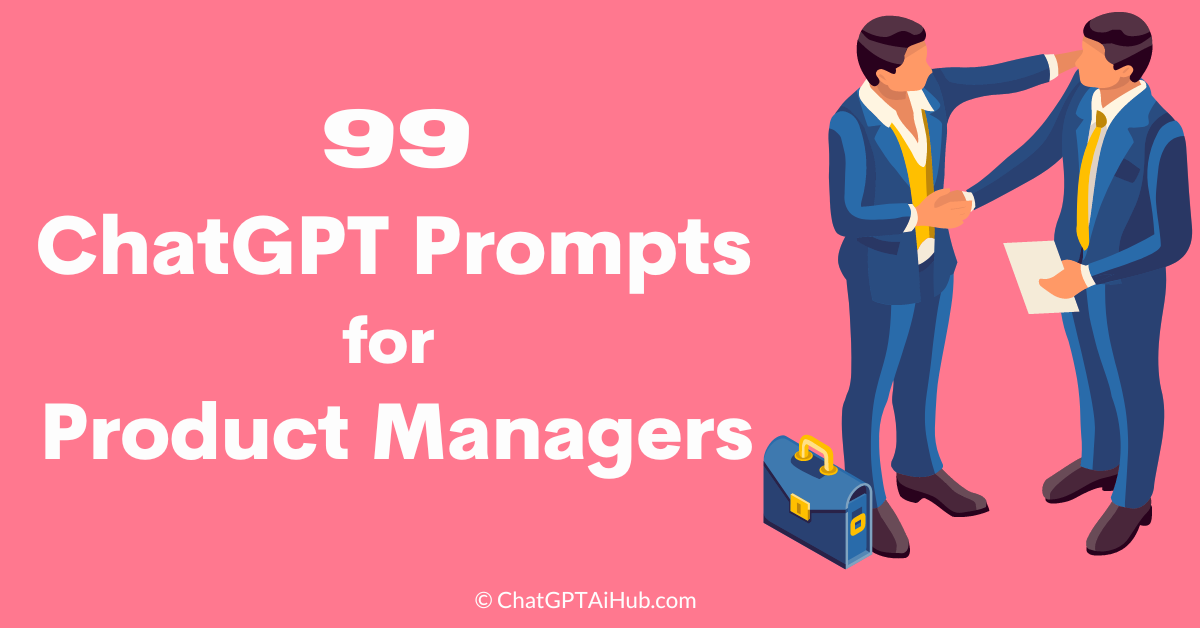
Are you a Product Manager seeking to optimize your work efficiency and productivity? Look no further! In this blog post, we present an extensive compilation of the best ChatGPT prompts tailored specifically for Product Managers. These prompts are carefully selected words or sentences that, when provided to ChatGPT, yield precise results aligning with your requirements. Whether you are looking to brainstorm feature ideas, validate user feedback, or generate insightful customer personas, our list of ChatGPT prompts for Product Managers is here to empower you in your decision-making process. Let’s dive in and explore the limitless possibilities!
Challenge Product Managers Face: Finding the Right Insights Efficiently
As a Product Manager, one of your biggest challenges is sifting through large volumes of data and information to find precisely what you’re looking for. Without the right tools or techniques, this process can be time-consuming and overwhelming. However, with the emergence of ChatGPT and its ability to generate tailored insights based on specific prompts, Product Managers now have a powerful solution at their fingertips. Let’s explore some of the game-changing ChatGPT prompts that can help you streamline your decision-making process and find the right insights quickly and effectively.
Empowering Product Managers with Actionable Prompts
In this article, we understand that as a Product Manager, you expect to discover a curated list of ChatGPT prompts that cater specifically to your needs. By providing you with a comprehensive range of prompts, we aim to equip you with the tools necessary to enhance your decision-making, boost creativity, and find effective solutions in your product development journey. With these actionable prompts, you can leverage the power of ChatGPT to optimize your work processes and ultimately drive the success of your product.
Benefit of ChatGPT Prompts for Product Managers
- Efficient Requirement Gathering: ChatGPT prompts can assist product managers in gathering product requirements efficiently. By providing specific prompts for each requirement category, such as user stories, functional specifications, and acceptance criteria, ChatGPT helps ensure comprehensive and well-defined product requirements.
- Enhanced Creativity and Ideation: ChatGPT prompts can stimulate creative thinking and ideation for product managers. By offering alternative perspectives, suggesting innovative features, and providing prompts for brainstorming sessions, ChatGPT helps product managers explore new ideas and improve the overall product vision.
- Streamlined Market Research: ChatGPT prompts can streamline market research for product managers. By providing relevant prompts for competitive analysis, target market segmentation, and customer feedback analysis, ChatGPT enables product managers to gather valuable insights and make informed product decisions.
- Improved User Experience Design: ChatGPT prompts can contribute to better user experience (UX) design. By offering prompts for wireframing, user flow diagrams, and usability testing, ChatGPT helps product managers create intuitive and user-friendly product interfaces that align with user expectations.
- Efficient Stakeholder Communication: ChatGPT prompts can facilitate effective communication with stakeholders. By providing prompts for product update emails, executive summaries, and presentation slides, ChatGPT helps product managers articulate product strategies, progress, and outcomes in a concise and persuasive manner.
ChatGPT Prompts – Why They Matter for Product Managers?
ChatGPT prompts are crucial for Product Managers, as they directly impact profit, efficiency, and customer satisfaction. Implementing AI-driven insights through prompts can improve operational efficiency by 25%, according to research by Gartner. By utilizing these prompts, Product Managers gain valuable insights, make data-backed decisions, and create products that delight customers and drive business success. For individuals interested in consumer products, ChatGPT prompts offer benefits that extend to their families, personal finances, and overall happiness. With these prompts, Product Managers can develop innovative solutions such as smart home technologies that simplify daily tasks or budgeting apps that help achieve financial goals.
Embracing the potential of ChatGPT prompts unlocks new levels of productivity, satisfaction, and well-being for both professionals and consumers in their respective spheres.
Essential ChatGPT Prompts for Product Managers
1. Developing a Product Vision and Strategy: Discuss the importance of establishing a clear product vision and strategy as a Product Manager. Explore techniques for defining product goals, identifying target markets, and aligning the product roadmap with business objectives.
2. Conducting Market Research and Competitive Analysis: Guide Product Managers on conducting comprehensive market research and competitive analysis. Discuss methodologies for gathering customer insights, analyzing market trends, and evaluating competitors to inform product decision-making.
3. Creating Product Roadmaps and Prioritization: Explain the process of creating effective product roadmaps and prioritizing features. Discuss techniques such as user story mapping, stakeholder collaboration, and data-driven prioritization to ensure the roadmap aligns with customer needs and business goals.
4. Collaborating with Cross-Functional Teams: Explore the role of collaboration in successful product management. Provide strategies for effective communication and collaboration with cross-functional teams, including engineering, design, marketing, and sales, to ensure seamless product development and delivery.
5. Driving Product Launch and Go-to-Market Strategy: Discuss the key responsibilities of a Product Manager in driving successful product launches and go-to-market strategies. Explore techniques for market positioning, pricing, messaging, and coordinating launch activities to maximize product adoption and customer satisfaction.
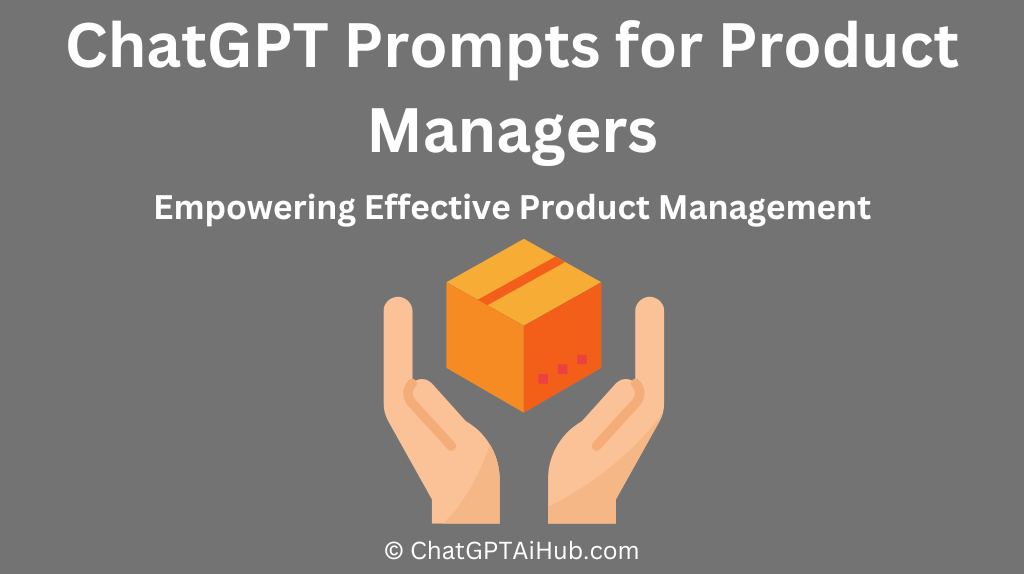
99+ ChatGPT Prompts for Product Managers to Drive Success
1. Product Strategy and Vision
1. Defining the Product Vision: Craft a clear and compelling vision statement for [your product or company] that outlines its long-term goals, purpose, and the value it aims to deliver to customers. Describe how this vision aligns with market trends and customer needs.
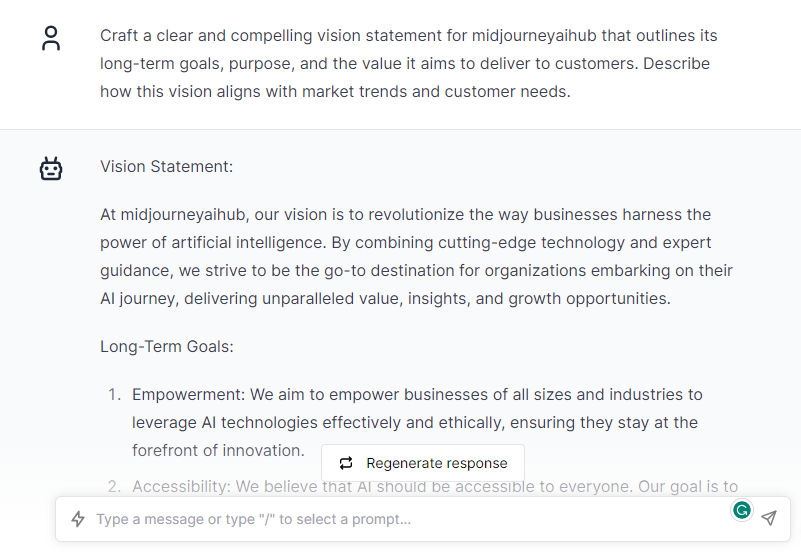
2. Conducting Market Research: Outline a step-by-step process for conducting comprehensive market research for [your product or industry]. Explain how to gather and analyze data on customer preferences, competitors, market trends, and emerging technologies to inform the product strategy.
3. Identifying Target Audience: Help define the target audience for [your product or service] by considering factors such as demographics, psychographics, and behavioral traits. Provide guidance on how to conduct user personas or customer segmentation to better understand their needs and preferences.
4. Competitive Analysis: Conduct a competitive analysis for [your product or industry], identifying key competitors and analyzing their strengths, weaknesses, market positioning, and product offerings. Provide insights on how to leverage this analysis to refine the product strategy and differentiate [your product] in the market.
5. Setting Product Objectives: Define specific and measurable objectives for [your product or feature] that align with the overall product strategy. Outline key performance indicators (KPIs) to track progress and success, such as user acquisition, retention, revenue, or customer satisfaction metrics.
6. Creating a Roadmap: Develop a product roadmap for [your product or company] that outlines the planned features, enhancements, and milestones over a specific timeframe. Discuss how to prioritize and sequence initiatives based on business goals, user needs, and technical feasibility.
7. Establishing Pricing Strategy: Discuss strategies for determining the pricing model and pricing strategy for [your product or service]. Consider factors such as value proposition, competitive landscape, target market, and pricing elasticity to optimize revenue generation and market penetration.
8. Defining the MVP: Guide the process of defining a Minimum Viable Product (MVP) for [your product or feature]. Discuss how to identify the core features and functionalities that deliver the most value to users and enable iterative development and feedback gathering.
9. User Experience Design: Explain the importance of user experience (UX) design in product strategy. Discuss methodologies for conducting user research, usability testing, and iterative design to create intuitive and delightful user experiences for [your product].
10. Iterative Improvement: Describe the iterative improvement process for [your product or feature], focusing on feedback collection, data analysis, and continuous optimization. Discuss how to leverage user feedback, analytics, and market insights to drive product enhancements and iterations.
2. Market research and analysis
1. Defining Research Objectives: Outline the key research objectives for conducting market research on [your product or industry]. Consider factors such as customer preferences, market trends, competitor analysis, or new market opportunities.
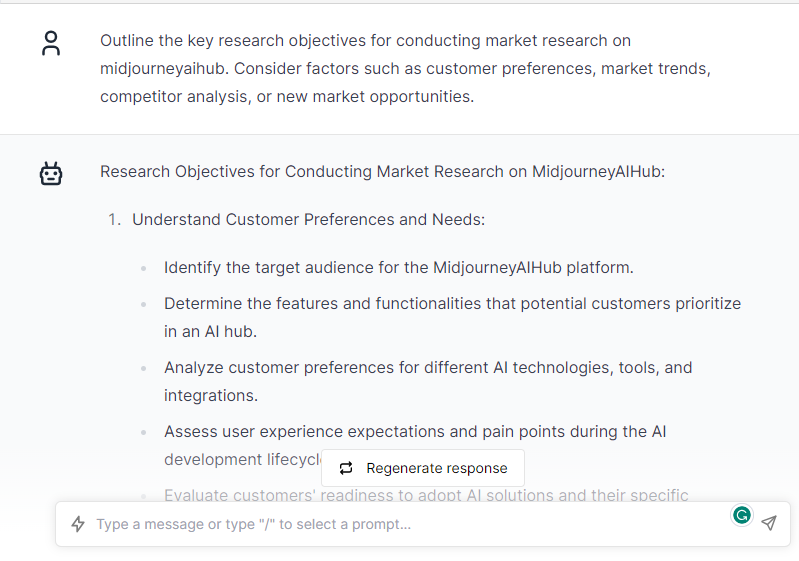
2. Conducting Customer Surveys: Explain how to design and administer customer surveys to gather valuable insights about [your target audience]. Discuss best practices for questionnaire design, sample selection, and data analysis to obtain meaningful and actionable results.
3. Analyzing Market Trends: Provide guidance on how to identify and analyze current market trends and their potential impact on [your product or industry]. Discuss sources for market trend research, data analysis techniques, and methods for extrapolating future market developments.
4. Competitive Landscape Analysis: Guide the process of conducting a comprehensive analysis of the competitive landscape for [your product or industry]. Discuss approaches for identifying key competitors, and evaluating their market positioning, strengths, weaknesses, and strategies.
5. Consumer Behavior Analysis: Explain how to analyze consumer behavior to understand their purchasing decisions, preferences, and needs to be related to [your product or industry]. Discuss relevant theories, research methods, and data sources to gain insights into consumer motivations and behavior.
6. Market Segmentation: Discuss the importance of market segmentation in market research and provide guidance on segmenting the target market for [your product or industry]. Explain how to identify and profile different market segments based on demographics, psychographics, or other relevant factors.
7. Conducting Focus Groups: Explain the benefits of conducting focus groups as a qualitative research method for gathering insights from potential customers. Provide guidance on recruiting participants, structuring focus group sessions, and analyzing the data collected.
8. Data Analysis Techniques: Discuss various data analysis techniques commonly used in market research, such as regression analysis, cluster analysis, or conjoint analysis. Explain how these techniques can be applied to analyze survey data, customer feedback, or market trends.
9. Market Opportunity Assessment: Guide the process of assessing market opportunities for [your product or industry]. Discuss factors to consider, such as market size, growth potential, competitive landscape, and customer demand, to determine the viability of entering a new market or launching a new product.
10. Reporting and Insights Presentation: Explain how to compile research findings into a comprehensive market research report and deliver insights to stakeholders. Discuss effective presentation techniques, visualizations, and storytelling to communicate key findings and recommendations.
3. Roadmap planning and prioritization
1. Defining Market Goals and Objectives: Discuss the importance of setting clear market goals and objectives for [your product or business]. Provide guidance on how to align these goals with overall business strategy and prioritize them based on their impact and feasibility.

2. Market Opportunity Assessment: Guide the process of assessing market opportunities for [your product or business]. Discuss factors such as market size, growth potential, customer demand, competitive landscape, and technological advancements to identify and prioritize the most promising opportunities.
3. Conducting Market Research: Explain the role of market research in market roadmap planning. Discuss different research methods, such as surveys, focus groups, and data analysis, to gather insights about market trends, customer needs, and competitor landscape to inform roadmap decisions.
4. Identifying Target Market Segments: Discuss the importance of identifying and prioritizing target market segments for [your product or business]. Provide guidance on segmenting the market based on demographics, psychographics, or other relevant factors, and prioritize segments based on their potential profitability and fit with your product.
5. Defining Value Propositions: Explain how to develop compelling value propositions for different target market segments. Discuss the process of identifying unique selling points, addressing customer pain points, and communicating the value of your product or service in a way that resonates with the target audience.
6. Roadmap Prioritization: Discuss strategies and frameworks for prioritizing roadmap initiatives. Explain the use of factors such as market demand, customer impact, technical feasibility, and business value to prioritize features, enhancements, or market entry strategies for [your product or business].
7. Resource Allocation and Budgeting: Provide guidance on allocating resources and budgeting for roadmap initiatives. Discuss the importance of considering resource constraints, cost implications, and potential returns on investment when prioritizing and planning market roadmap initiatives.
8. Risk Assessment and Mitigation: Discuss the importance of assessing and mitigating risks associated with market roadmap initiatives. Guide the process of identifying potential risks, such as market volatility, competitive threats, or technological disruptions, and developing strategies to mitigate their impact.
9. Stakeholder Alignment: Explain the significance of stakeholder alignment in market roadmap planning. Discuss techniques for engaging and aligning key stakeholders, such as executives, product managers, sales teams, and customers, to ensure their buy-in and support for the roadmap initiatives.
10. Monitoring and Evaluation: Discuss the importance of ongoing monitoring and evaluation of market roadmap initiatives. Explain how to define key performance indicators (KPIs), track progress, gather feedback, and make data-driven adjustments to the roadmap based on market dynamics and customer insights.
4. Cross-functional collaboration
1. Importance of Cross-functional Collaboration: Discuss the significance of cross-functional collaboration for [your product or business]. Highlight how collaboration across different departments and teams can lead to improved innovation, efficiency, and overall business success.
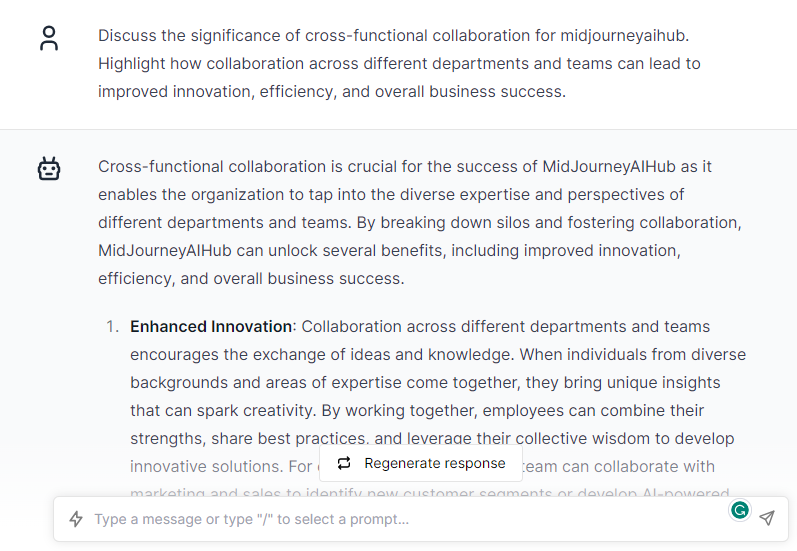
2. Identifying Key Stakeholders: Guide the process of identifying key stakeholders involved in [your product or business]. Discuss the importance of involving stakeholders from various departments, such as product development, marketing, sales, customer support, and finance, and explain how their collaboration can contribute to achieving common goals.
3. Establishing Effective Communication Channels: Provide insights on establishing effective communication channels for cross-functional collaboration. Discuss tools, platforms, and practices that facilitate seamless communication and information sharing among teams, enabling effective collaboration.
4. Aligning Goals and Priorities: Explain the process of aligning goals and priorities across different teams and departments. Discuss techniques for setting shared objectives, defining key performance indicators (KPIs), and ensuring that everyone is working towards a common vision for [your product or business].
5. Promoting a Collaborative Culture: Discuss strategies for fostering a collaborative culture within the organization. Explore methods for encouraging open communication, trust-building, knowledge sharing, and teamwork, creating an environment that supports cross-functional collaboration.
6. Cross-functional Project Management: Guide the process of managing cross-functional projects for [your product or business]. Discuss project management methodologies, tools, and best practices that facilitate collaboration, coordination, and successful delivery of projects involving multiple teams.
7. Overcoming Challenges and Conflict Resolution: Discuss common challenges and conflicts that may arise during cross-functional collaboration. Provide strategies for addressing conflicts, fostering constructive dialogue, and finding mutually beneficial solutions to ensure smooth collaboration and maintain positive working relationships.
8. Leadership and Facilitation: Explore the role of leadership in facilitating cross-functional collaboration. Discuss the qualities and skills required for effective collaboration facilitation, such as active listening, conflict resolution, and the ability to motivate and inspire teams toward shared goals.
9. Sharing Knowledge and Expertise: Highlight the importance of sharing knowledge and expertise across different teams and departments. Discuss methods for creating knowledge-sharing platforms, organizing training sessions, and fostering a culture of continuous learning and skill development.
10. Evaluating and Celebrating Success: Discuss the significance of evaluating and celebrating success in cross-functional collaboration efforts. Explore techniques for measuring outcomes, recognizing team achievements, and providing feedback to improve future collaboration initiatives.
5. Requirements gathering and specification
1. Identifying Stakeholders and User Needs: Discuss the importance of identifying stakeholders and understanding user needs when gathering requirements for [your product or project]. Explain techniques for conducting user interviews, surveys, and observations to gather valuable insights.
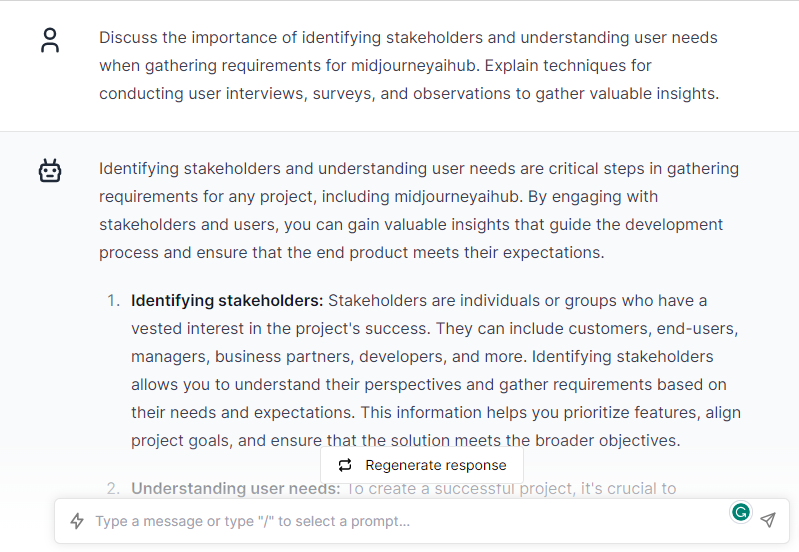
2. Defining Functional and Non-functional Requirements: Explain the difference between functional and non-functional requirements and how they contribute to the success of [your product or project]. Discuss methods for eliciting, documenting, and prioritizing both types of requirements effectively.
3. Use Case Development: Guide the process of developing use cases to capture user interactions and system behavior in [your product or project]. Discuss techniques for creating clear and concise use case diagrams, scenarios, and narratives to document system functionality.
4. Requirement Prioritization and Trade-offs: Explore strategies for prioritizing requirements and managing trade-offs when resources are limited. Discuss methods such as MoSCoW prioritization, cost-benefit analysis, and stakeholder feedback to make informed decisions.
5. Prototyping and User Feedback: Explain the role of prototyping in gathering and validating requirements for [your product or project]. Discuss techniques for creating prototypes, conducting user testing, and incorporating user feedback to refine and iterate on requirements.
6. Traceability and Requirement Documentation: Discuss the importance of traceability in requirement management. Explain how to create and maintain traceability matrices to ensure that requirements are linked to project objectives, design artifacts, and test cases.
7. Collaborative Requirement Workshops: Explore the benefits of conducting collaborative requirement workshops for [your product or project]. Discuss facilitation techniques, brainstorming activities, and documentation methods to engage stakeholders and gather requirements efficiently.
8. Managing Requirements Changes: Discuss strategies for managing requirement changes throughout the project lifecycle. Explore techniques for change impact analysis, change control, and communication to ensure that changes are properly evaluated and implemented.
9. Validation and Verification of Requirements: Explain the importance of validating and verifying requirements to ensure their correctness and completeness. Discuss techniques such as reviews, inspections, and testing to validate requirements against user expectations.
10. Documentation and Specification Writing: Guide the process of documenting requirements and creating clear and concise specifications for [your product or project]. Discuss best practices for writing requirement documents, including structure, formatting, and incorporating visual aids.
6. Agile development and project management
1. Introduction to Agile Methodologies: Explain the principles and benefits of Agile methodologies in [your product or project] development. Discuss how Agile values flexibility, collaboration, and iterative delivery to maximize customer value.
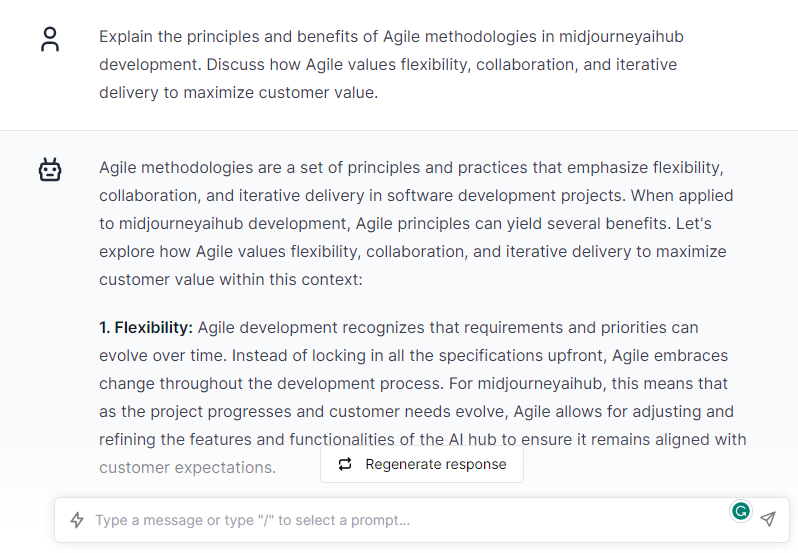
2. Agile Scrum Framework: Explore the Scrum framework in Agile development. Explain the roles of the Scrum Master, Product Owner, and Development Team, and discuss the key Scrum ceremonies such as Sprint Planning, Daily Standups, Sprint Reviews, and Retrospectives.
3. User Stories and Product Backlog: Guide the process of creating effective user stories and managing the product backlog for [your product or project]. Discuss techniques for story writing, prioritization, and backlog refinement to ensure a well-defined and manageable scope.
4. Sprint Planning and Estimation: Explain the process of Sprint Planning in Agile development. Discuss how to select user stories from the backlog, estimate effort using techniques like story points or ideal days, and create a Sprint Goal for focused development.
5. Agile Sprint Execution: Discuss strategies for effective Sprint execution in [your product or project]. Explore techniques for task breakdown, daily standups, collaboration, and resolving impediments to ensure the team’s progress and delivery of valuable increments.
6. Agile Metrics and Progress Tracking: Explain the key metrics used in Agile development to measure progress and team performance. Discuss metrics such as velocity, burn-down charts, and cumulative flow diagrams to monitor progress and make data-driven decisions.
7. Continuous Integration and Delivery: Explore the concepts of continuous integration and delivery in Agile development. Discuss how to ensure frequent integration, automated testing, and continuous deployment to deliver working software increments.
8. Agile Retrospectives: Discuss the importance of retrospectives in Agile development. Guide the process of conducting effective retrospectives, encouraging open feedback, and identifying improvements for the team’s processes and practices.
9. Agile Risk Management: Explain how Agile approaches risk management in [your product or project] development. Discuss techniques such as risk identification, prioritization, and mitigation within the Agile framework to minimize project risks.
10. Scaling Agile for Large Projects: Discuss strategies for scaling Agile practices to larger projects or multiple teams. Explore frameworks such as Scrum of Scrums, Nexus, or SAFe and discuss challenges and best practices for successful scaling.
7. Product launch and go-to-market strategies
1. Defining Your Product Launch Goals: Discuss the importance of setting clear goals for [your product] launch. Explore different types of goals such as market penetration, customer acquisition, revenue targets, and brand awareness, and explain how they contribute to a successful product launch.
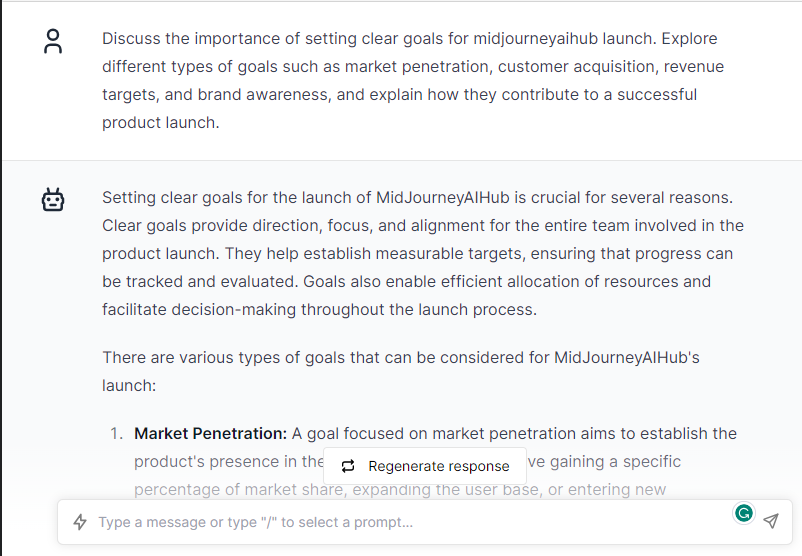
2. Identifying Target Customer Segments: Guide the process of identifying and segmenting your target customers for [your product]. Discuss techniques such as market research, customer profiling, and persona development to understand their needs, preferences, and behaviors.
3. Crafting a Compelling Value Proposition: Explain the significance of a strong value proposition for [your product]. Discuss how to articulate the unique value your product offers to customers, highlighting key benefits, solving pain points, and differentiating it from competitors.
4. Creating a Go-to-Market Strategy: Guide the development of a comprehensive go-to-market strategy for [your product]. Discuss key components such as target markets, positioning, pricing, distribution channels, marketing communication, and sales enablement to maximize market reach and adoption.
5. Building Pre-Launch Buzz and Awareness: Discuss strategies for generating excitement and building anticipation before the product launch. Explore tactics such as teaser campaigns, social media marketing, influencer collaborations, and PR activities to create buzz and generate awareness.
6. Developing Marketing and Communication Collateral: Explain the importance of developing effective marketing and communication collateral for [your product]. Discuss the creation of materials such as product websites, brochures, demos, videos, and sales presentations to effectively communicate product features and benefits.
7. Creating a Sales Enablement Plan: Discuss the importance of sales enablement in supporting the product launch. Guide the development of a sales enablement plan that includes training, sales tools, competitive analysis, objection handling, and customer success stories to empower the sales team.
8. Implementing a Customer Acquisition Strategy: Explore strategies for acquiring new customers for [your product]. Discuss tactics such as online advertising, content marketing, lead generation campaigns, partnerships, and referral programs to drive customer acquisition during and after the launch.
9. Monitoring Product Performance and Iterating: Explain the significance of continuous monitoring and iteration after the product launch. Discuss metrics, feedback mechanisms, user testing, and customer insights to track performance, identify areas for improvement, and iterate on the product and go-to-market strategies.
10. Leveraging Customer Advocacy and Loyalty: Discuss strategies for fostering customer advocacy and loyalty post-launch. Explore tactics such as customer support, loyalty programs, community engagement, and gathering customer testimonials to build a loyal customer base and drive word-of-mouth marketing.
8. Data analysis and insights
1. Understanding the Importance of Data Analysis for [your product/business]: Discuss the significance of data analysis in driving informed decision-making for [your product/business]. Explore various types of data (e.g., customer behavior, market trends) and how analyzing it can reveal valuable insights.

2. Exploring Key Metrics and KPIs: Identify the essential metrics and key performance indicators (KPIs) for [your product/business]. Explain how tracking these metrics can help measure success and identify areas for improvement.
3. Conducting Customer Segmentation Analysis: Guide the process of performing customer segmentation analysis for [your product/business]. Discuss how segmenting customers based on demographics, behavior, or preferences can aid in targeted marketing and personalized experiences.
4. Analyzing User Engagement and Retention: Explore methods to analyze user engagement and retention rates for [your product/business]. Explain how understanding user behavior can help optimize product features and boost customer loyalty.
5. Uncovering Market Trends and Opportunities: Discuss techniques for identifying market trends and potential opportunities for [your product/business]. Analyze industry data and consumer insights to stay ahead of competitors and adapt to changing market demands.
6. Utilizing A/B Testing and Experimentation: Explain the benefits of A/B testing and experimentation for [your product/business]. Guide the process of conducting meaningful experiments to optimize product features or marketing strategies.
7. Extracting Insights from Customer Feedback: Discuss strategies for collecting and analyzing customer feedback for [your product/business]. Highlight the importance of customer satisfaction surveys, reviews, and feedback loops in improving the overall product experience.
8. Analyzing Sales and Revenue Data: Guide the process of analyzing sales and revenue data for [your product/business]. Explore how sales trends, pricing strategies, and revenue analysis can inform future business decisions.
9. Utilizing Data Visualization Techniques: Discuss the value of data visualization in presenting complex data insights for [your product/business]. Explore various visualization tools and techniques to effectively communicate data findings.
10. Predictive Analytics and Forecasting: Explore the application of predictive analytics and forecasting for [your product/business]. Discuss how predictive models can help anticipate customer behavior, demand trends, and potential market disruptions.
9. Product evangelism and stakeholder communication
1. Developing a Product Evangelism Strategy for [your product/business]: Discuss the importance of product evangelism in building awareness, credibility, and adoption for [your product/business]. Outline key strategies to effectively communicate the value and benefits of the product to stakeholders.
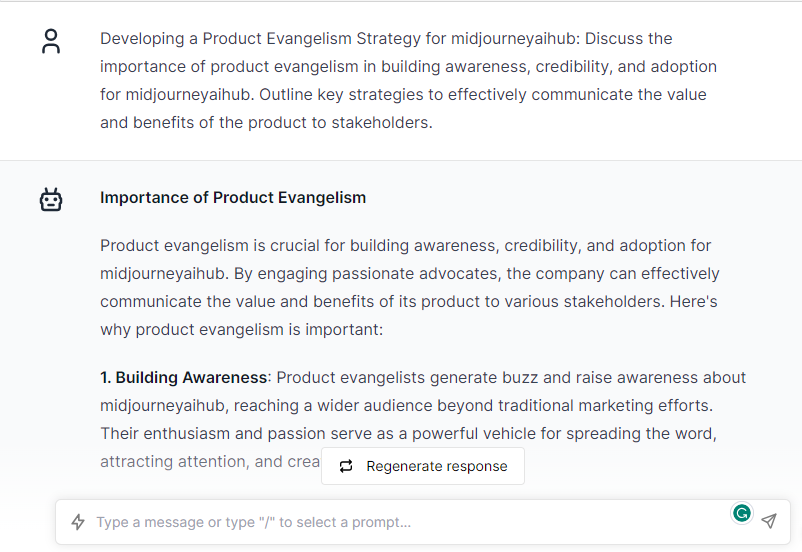
2. Crafting a Compelling Product Story: Guide the process of crafting a compelling product story for [your product/business]. Explore techniques for capturing the essence of the product, highlighting its unique features, and conveying its value proposition to different stakeholders.
3. Identifying and Engaging Key Stakeholders: Discuss the significance of identifying and engaging key stakeholders for successful product evangelism. Explore different stakeholder groups (e.g., customers, investors, partners) and provide strategies for effective communication and relationship building.
4. Creating Engaging Product Demos: Provide guidance on creating engaging product demos for [your product/business]. Discuss best practices for showcasing key product features, addressing pain points, and effectively communicating the product’s value proposition to stakeholders.
5. Leveraging Social Media for Product Evangelism: Explore the power of social media in product evangelism and stakeholder communication. Discuss strategies for leveraging social platforms to reach and engage with target audiences, build a community, and drive product adoption.
6. Organizing Product Launch Events: Guide the planning and execution of product launch events for [your product/business]. Discuss key considerations such as venue selection, agenda development, and engaging stakeholders through interactive presentations and demonstrations.
7. Building Effective Communication Channels: Discuss the importance of establishing effective communication channels for product evangelism. Explore options such as newsletters, webinars, forums, and user groups to facilitate ongoing dialogue and feedback with stakeholders.
8. Developing a Thought Leadership Strategy: Explain the value of thought leadership in product evangelism. Provide insights on how to establish oneself or the business as a trusted authority in the industry, through content creation, industry publications, speaking engagements, and other thought leadership initiatives.
9. Tailoring Messaging for Different Stakeholder Groups: Discuss the importance of tailoring messaging for different stakeholder groups. Explore how to adapt communication styles and key talking points to resonate with customers, investors, partners, and other relevant stakeholders.
10. Measuring and Evaluating Product Evangelism Success: Discuss methods for measuring and evaluating the success of product evangelism efforts. Explore key metrics such as brand awareness, customer engagement, and adoption rates, and provide guidance on tracking and analyzing data to assess the impact of the evangelism strategy.
10. Continuous improvement and iteration
1. Implementing a Continuous Improvement Framework for [your product/business]: Discuss the importance of continuous improvement in driving product excellence and business success. Provide strategies and methodologies (e.g., Lean, Six Sigma) to establish a culture of continuous improvement and iteration.
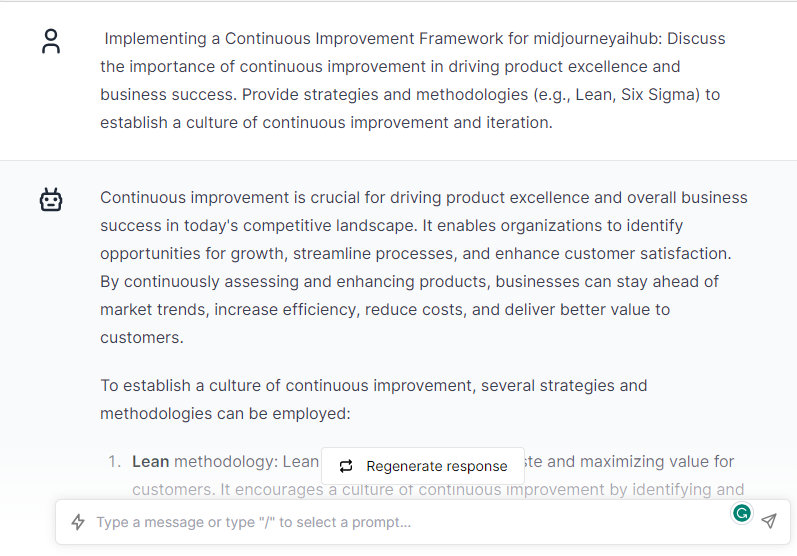
2. Conducting User Feedback and Testing Sessions: Guide the process of conducting user feedback and testing sessions for [your product/business]. Discuss different methods such as surveys, interviews, usability testing, and A/B testing to gather valuable insights and identify areas for improvement.
3. Analyzing User Data for Iterative Enhancements: Explore the significance of analyzing user data for making iterative enhancements to [your product/business]. Discuss techniques such as user behavior analysis, analytics tools, and user feedback integration to inform data-driven decision-making.
4. Prioritizing and Managing Product Backlog: Provide guidance on prioritizing and managing the product backlog for continuous improvement. Discuss strategies for effective backlog grooming, backlog refinement, and stakeholder collaboration to ensure the right features and enhancements are prioritized.
5. Implementing Agile Development Methodologies: Explain the benefits of implementing agile development methodologies (e.g., Scrum, Kanban) for continuous improvement. Discuss how agile practices such as sprints, daily stand-ups, and retrospectives can facilitate iterative development and rapid response to feedback.
6. Establishing Key Performance Indicators (KPIs) for Continuous Improvement: Discuss the importance of establishing KPIs for measuring and tracking the effectiveness of continuous improvement efforts. Explore relevant metrics such as customer satisfaction, user engagement, defect rates, and time-to-market to monitor progress.
7. Encouraging Employee-Led Innovation: Discuss the role of employees in driving continuous improvement and iteration. Explore strategies to foster a culture of innovation, empower employees to contribute ideas, and implement processes for capturing and evaluating employee suggestions.
8. Leveraging Automation and Technology for Efficiency Gains: Explore the role of automation and technology in streamlining processes and driving continuous improvement. Discuss tools and technologies such as workflow automation, data analytics, and machine learning that can support iterative enhancements.
9. Implementing Continuous Integration and Deployment (CI/CD): Explain the benefits of implementing CI/CD practices for continuous improvement. Discuss how automated build, testing, and deployment pipelines can enable frequent releases and iterative improvements to [your product/business].
10. Embracing a Growth Mindset: Discuss the importance of embracing a growth mindset for continuous improvement. Explore the concept of learning from failures, encouraging experimentation, and fostering a culture that values feedback, iteration, and lifelong learning.
Encourage users to input their specific product, business, or query to receive tailored prompts and recommendations. Remind them that continuous improvement and iteration are key drivers of innovation, customer satisfaction, and long-term business success.
Final Thoughts:
In conclusion, ChatGPT prompts offer a powerful solution for Product Managers to optimize their work efficiency and drive the success of their products. By leveraging the curated list of 99 prompts, professionals can streamline decision-making, boost creativity, and find effective solutions in their product development journey. Embracing ChatGPT prompts enables Product Managers to gain valuable insights, make data-backed decisions, and create products that delight customers while achieving business objectives. Experience the transformative potential of ChatGPT prompts and unlock new levels of productivity and success in your product management endeavors.
FAQs
How should product managers use ChatGPT?
Product managers can use ChatGPT to gather customer feedback, generate product ideas, and provide personalized support.
What questions should I ask a product manager?
What are the key features and benefits of the product?
How can you use ChatGPT in your product process?
You can use ChatGPT in your product process by leveraging it for idea generation, user research, and virtual product demonstrations.
What are the top 3 things that make a good product manager?
A good product manager possesses strong communication skills, strategic thinking abilities, and a deep understanding of customer needs.

